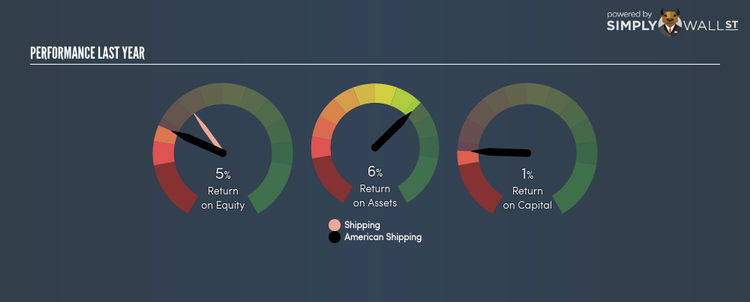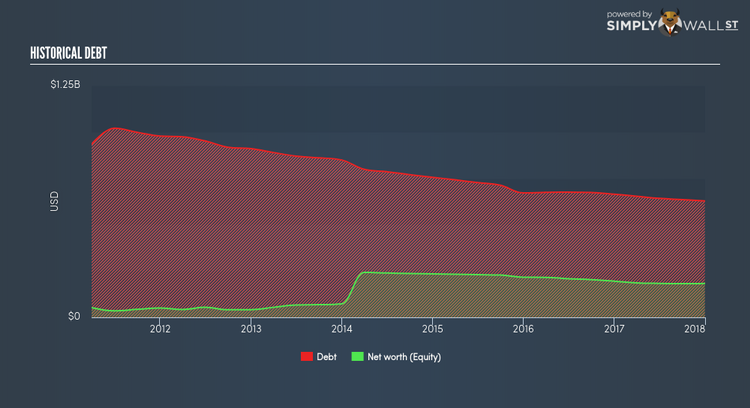With An ROE Of 5.35%, Can American Shipping Company ASA (OB:AMSC) Catch Up To The Industry?

American Shipping Company ASA (OB:AMSC) generated a below-average return on equity of 5.35% in the past 12 months, while its industry returned 10.23%. AMSC’s results could indicate a relatively inefficient operation to its peers, and while this may be the case, it is important to understand what ROE is made up of and how it should be interpreted. Knowing these components could change your view on AMSC’s performance. Today I will look at how components such as financial leverage can influence ROE which may impact the sustainability of AMSC’s returns. See our latest analysis for American Shipping
What you must know about ROE
Return on Equity (ROE) weighs American Shipping’s profit against the level of its shareholders’ equity. An ROE of 5.35% implies NOK0.05 returned on every NOK1 invested. While a higher ROE is preferred in most cases, there are several other factors we should consider before drawing any conclusions.
Return on Equity = Net Profit ÷ Shareholders Equity
ROE is assessed against cost of equity, which is measured using the Capital Asset Pricing Model (CAPM) – but let’s not dive into the details of that today. For now, let’s just look at the cost of equity number for American Shipping, which is 18.26%. Given a discrepancy of -12.91% between return and cost, this indicated that American Shipping may be paying more for its capital than what it’s generating in return. ROE can be broken down into three different ratios: net profit margin, asset turnover, and financial leverage. This is called the Dupont Formula:
Dupont Formula
ROE = profit margin × asset turnover × financial leverage
ROE = (annual net profit ÷ sales) × (sales ÷ assets) × (assets ÷ shareholders’ equity)
ROE = annual net profit ÷ shareholders’ equity
The first component is profit margin, which measures how much of sales is retained after the company pays for all its expenses. The other component, asset turnover, illustrates how much revenue American Shipping can make from its asset base. Finally, financial leverage will be our main focus today. It shows how much of assets are funded by equity and can show how sustainable the company’s capital structure is. Since ROE can be inflated by excessive debt, we need to examine American Shipping’s debt-to-equity level. The debt-to-equity ratio currently stands at over 2.5 times, meaning the below-average ratio is already being driven by a large amount of debt.
Next Steps:
ROE is a simple yet informative ratio, illustrating the various components that each measure the quality of the overall stock. American Shipping’s ROE is underwhelming relative to the industry average, and its returns were also not strong enough to cover its own cost of equity. However, ROE is not likely to be inflated by excessive debt funding, giving shareholders more conviction in the sustainability of returns, which has headroom to increase further. Although ROE can be a useful metric, it is only a small part of diligent research.
For American Shipping, I’ve put together three essential aspects you should further examine:
Financial Health: Does it have a healthy balance sheet? Take a look at our free balance sheet analysis with six simple checks on key factors like leverage and risk.
Valuation: What is American Shipping worth today? Is the stock undervalued, even when its growth outlook is factored into its intrinsic value? The intrinsic value infographic in our free research report helps visualize whether American Shipping is currently mispriced by the market.
Other High-Growth Alternatives : Are there other high-growth stocks you could be holding instead of American Shipping? Explore our interactive list of stocks with large growth potential to get an idea of what else is out there you may be missing!
To help readers see pass the short term volatility of the financial market, we aim to bring you a long-term focused research analysis purely driven by fundamental data. Note that our analysis does not factor in the latest price sensitive company announcements.
The author is an independent contributor and at the time of publication had no position in the stocks mentioned.


